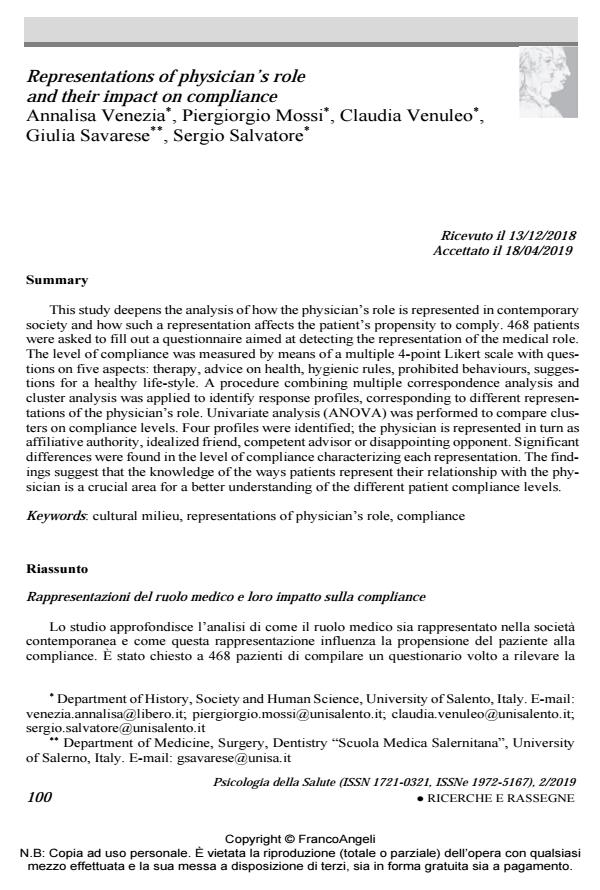Representations of physician’s role and their impact on compliance
Journal title PSICOLOGIA DELLA SALUTE
Author/s Annalisa Venezia, Piergiorgio Mossi, Claudia Venuleo, Giulia Savarese, Sergio Salvatore
Publishing Year 2019 Issue 2019/2
Language English Pages 22 P. 100-121 File size 294 KB
DOI 10.3280/PDS2019-002005
DOI is like a bar code for intellectual property: to have more infomation
click here
Below, you can see the article first page
If you want to buy this article in PDF format, you can do it, following the instructions to buy download credits

FrancoAngeli is member of Publishers International Linking Association, Inc (PILA), a not-for-profit association which run the CrossRef service enabling links to and from online scholarly content.
This study deepens the analysis of how the physician’s role is represented in contemporary society and how such a representation affects the patient’s propensity to comply. 468 patients were asked to fill out a questionnaire aimed at detecting the representation of the medical role. The level of compliance was measured by means of a multiple 4-point Likert scale with ques-tions on five aspects: therapy, advice on health, hygienic rules, prohibited behaviours, sugges-tions for a healthy life-style. A procedure combining multiple correspondence analysis and cluster analysis was applied to identify response profiles, corresponding to different represen-tations of the physician’s role. Univariate analysis (ANOVA) was performed to compare clus-ters on compliance levels. Four profiles were identified; the physician is represented in turn as affiliative authority, idealized friend, competent advisor or disappointing opponent. Significant differences were found in the level of compliance characterizing each representation. The find-ings suggest that the knowledge of the ways patients represent their relationship with the phy-sician is a crucial area for a better understanding of the different patient compliance levels.
Keywords: Cultural milieu, representations of physician’s role, compliance
- Foundation of Ethics-Based Practices Raffaele De Luca Picione, Maria Francesca Freda, Livia Savarese, pp.115 (ISBN:978-3-030-83665-8)
- Methods and Instruments in the Study of Meaning-Making Claudia Venuleo, Tiziana Marinaci, Giulia Savarese, Annalisa Venezia, pp.169 (ISBN:978-3-031-21994-8)
- The Meaning of Living in the Time of COVID-19. A Large Sample Narrative Inquiry Claudia Venuleo, Tiziana Marinaci, Alessandro Gennaro, Arianna Palmieri, in Frontiers in Psychology 577077/2020
DOI: 10.3389/fpsyg.2020.577077 - Methods and Instruments in the Study of Meaning-Making Sergio Salvatore, Raffaele De Luca Picione, pp.3 (ISBN:978-3-031-21994-8)
- The Search for Origins by the Adopted Children: The Perspective of Adoptive Mothers in the Italian Context Barbara Cordella, Rossini Susanna, Paola Elia, Matteo Reho, Alessandro Gennaro, in Adoption Quarterly /2024 pp.191
DOI: 10.1080/10926755.2023.2172507 - Caregivers’ Sensemaking of Children’s Hereditary Angioedema: A Semiotic Narrative Analysis of the Sense of Grip on the Disease Maria Francesca Freda, Livia Savarese, Pasquale Dolce, Raffaele De Luca Picione, in Frontiers in Psychology 2609/2019
DOI: 10.3389/fpsyg.2019.02609 - Making sense of the COVID-19 pandemic: A qualitative longitudinal study investigating the first and second wave in Italy Tiziana Marinaci, Claudia Venuleo, Alessandro Gennaro, Gordon Sammut, in Heliyon e07891/2021 pp.e07891
DOI: 10.1016/j.heliyon.2021.e07891
Annalisa Venezia, Piergiorgio Mossi, Claudia Venuleo, Giulia Savarese, Sergio Salvatore, Representations of physician’s role and their impact on compliance in "PSICOLOGIA DELLA SALUTE" 2/2019, pp 100-121, DOI: 10.3280/PDS2019-002005